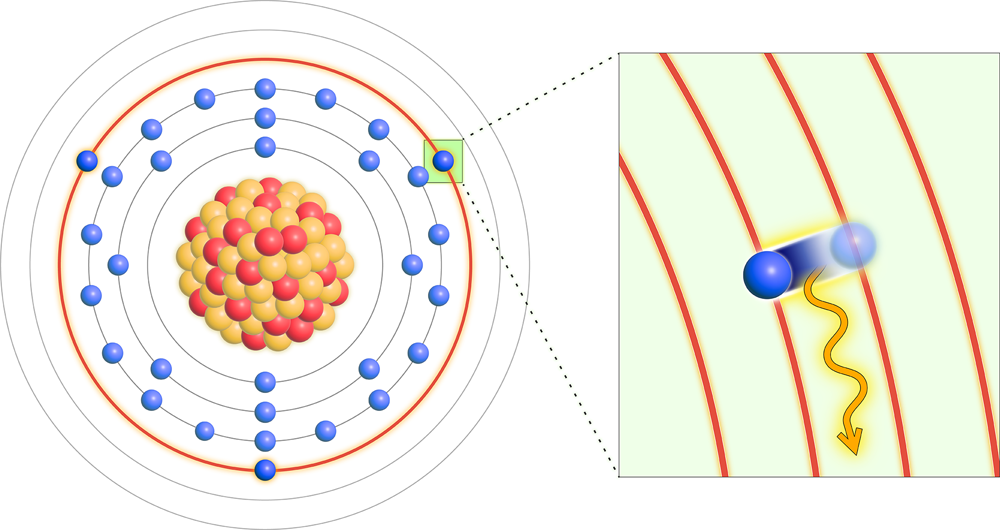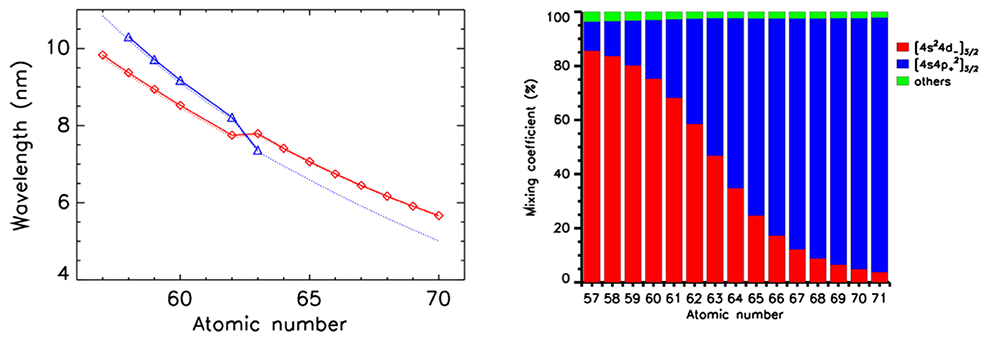Experimental and Theoretical Verification of Atomic Physics Effects Specific to Highly Charged Heavy Ions
We have investigated atomic number (Z) dependence of transition wavelengths of gallium-like lanthanide ions, based on spectroscopic measurements in the Large Helical Device (LHD) and an electron beam ion trap (EBIT). A peculiar Z dependence of the wavelength was found between Z=62 and 63. High-precision atomic structure calculation verified that strong configuration interaction and spin-orbit interaction specific to highly charged heavy ions play an important role in this peculiar behavior.


In the Large Helical Device (LHD), systematic observations of emission spectra from highly charged lanthanide ions have been carried out, exploiting its characteristic that high-temperature plasmas are stably sustainable. In this study, we focus on atomic number (Z) dependence of spectral lines of gallium-like ions (with 31 electrons), emitted in the extreme ultraviolet (EUV) region.
In the independent-particle model, electron configuration of the ground state of gallium-like ions is expressed as [4s24p-]1/2 if the inner closed shells are neglected. Due to strong spin-orbit interactions in highly charged heavy ions, the state of coupling of orbital and spin angular momenta (anti-parallel or parallel) is indicated with subscripts "-" or "+". The spectral lines for the transitions from the excited state [4s24d-]3/2 to the ground state [4s24p-]1/2 are emitted in the EUV region. In general, wavelengths for a specific transition move to shorter wavelength as Z increases. As shown in red in the left figure, however, the transition wavelength observed in the LHD shifts from one curve to another between Z=62 (samarium) and 63 (europium), which consequently results in a peculiar behavior that the wavelength for Z=63 is longer than that for Z=62. As for europium, we have also observed the same line in an electron beam ion trap (EBIT) at the University of Electro-Communications (UEC) to confirm that the line is truly emitted from gallium-like ions.
In order to understand the underlying physics of this phenomenon, we have carried out high-precision theoretical calculations of energy levels and transition wavelengths by the GRASP code, in which the multi-configuration Dirac-Flock (MCDF) method is adopted. As shown in the left figure with a broken line, the calculated wavelengths are in good agreement with the measurements.
In the independent-particle model, the electron configuration of multi-electron atoms can be expressed as 1s22s22p6... though this is a kind of approximation (mean field approximation). This estimate is sometimes insufficient for expressing the electron states of highly charged heavy ions. By the MCDF method, it is assumed that the electron state is expressed as a linear combination of several electron configurations, and the mixing coefficients are optimized to further improve the approximation. For example, the [4s24d-]3/2 configuration is mixed well with the [4s4p+2]3/2 one. This phenomenon is called configuration interaction.
The configuration interaction becomes stronger as the energies of the two become closer to each other. The energy of the [4s4p+2]3/2 configuration is strongly affected by spin-orbit splitting because the spin of a 4p orbital is opposite to that of the ground state [4s24p-]1/2. As Z increases, the energy of the [4s4p+2]3/2 configuration overtakes that of [4s24d-]3/2 one, which means that the mixing coefficient depends on Z. The calculated mixing coefficients for the higher energy level of the two levels are shown in the right figure. The mixing coefficient of the [4s4p+2]3/2 configuration overtakes that of the [4s24d-]3/2 one between Z=62 and 63, which implies that the two configurations are almost equally mixed around Z=62 and 63. This situation is also the case for the other lower energy level, except that the two configurations are exchanged. The labeling of the energy level is switched between 62 and 63, reflecting that the energy level is labeled by the leading configuration. This is why the Z dependence of the transition wavelength is peculiar, as mentioned above.
In principle, the transition from the excited state [4s4p+2]3/2 to ground state should be a very weak forbidden transition. However, as a result of the mixing with the [4s24d-]3/2 state, this transition emits more strongly, which results in two lines near Z=62 and 63. In reality, this spectral line could be observed in the LHD, as shown in a blue line in the left figure. In summary, the present results demonstrate the importance of atomic physics effects specific to highly charged heavy ions, such as the strong configuration interaction and spin-orbit splitting, based on the experimental data and high-precision theoretical calculation. This study is expected to contribute to the development of the physics of highly charged ions.
It has been carried out by the research group of F. Koike (Sophia Univ.), N. Nakamura (UEC), C. Suzuki, I. Murakami, et al. (NIFS). This research result was published in Physical Review A, a journal by the American Physical Society, on March 4, 2022.
This research result was also published in Plasma and Fusion Research, an online journal by the Japan Society of Plasma Science and Nuclear Fusion Research, on March 30, 2022. With the success of the first experiment performed in 2019, we conducted a second experiment that injected pellets made of a mixture of hydrogen and neon in the 23rd cycle in 2021. We are looking forward to obtaining new findings and interesting analysis from the new data.
